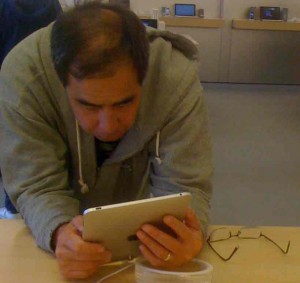Touch is barely taught in schools. There’s the basics, scratchy, softy, smooth, but for the most part, we develop our sense of touch informally, through experience. I’ve been thinking about touch and tactileness a lot since the introduction of the iPhone and now iPad. Directing text through our fingers seems different than using a mouse. It feels closer and more responsive. What does this mean for our reading experience? Touch screens bring us closer to the feeling of a book. Tablets place the texts in our hands again, instead of on a screen. We’re closer, turning the pages with our fingers instead of a mouse. iPad empowers our fingers to highlight texts and move them around the screen. It brings the book back to our lap, in our hands, closer, and more under our control.

The iPod taught us that if we want to scroll down, we move our fingers clockwise, to move up, counter-clockwise, and the speed of our movements affect how quickly the text will scroll. While this movement isn’t intuitive, it’s quickly learned. To thumb through a book, iPad teaches us to glide our finger right to left, similar to how we move printed pages. To change screens, the iPhone and iPad require the same right to left glide. These actions have become second-nature to most users. What other movements will our new technologies teach us?

